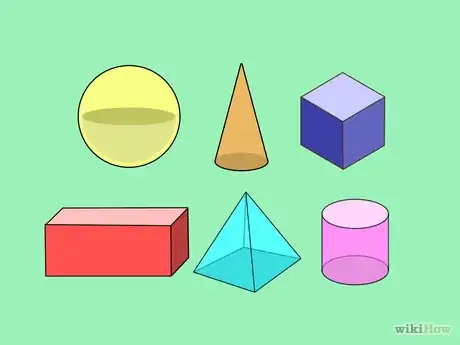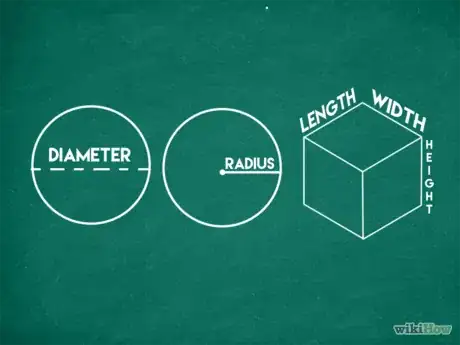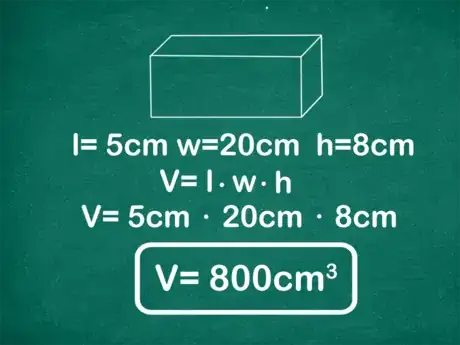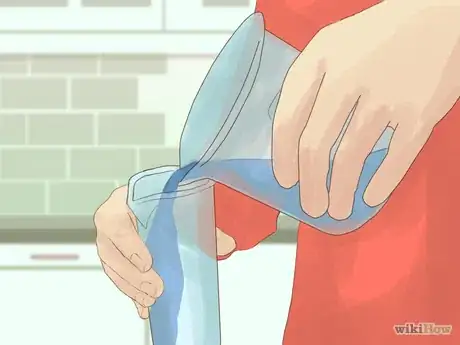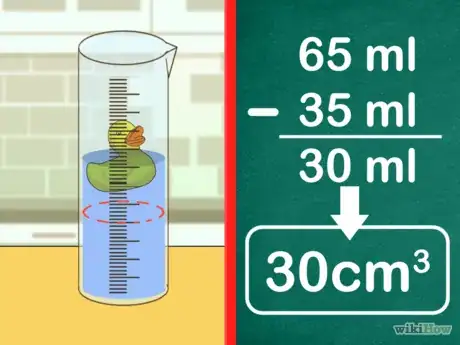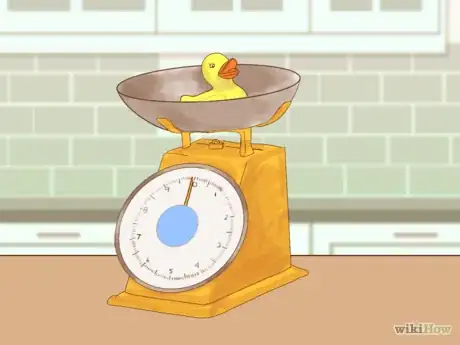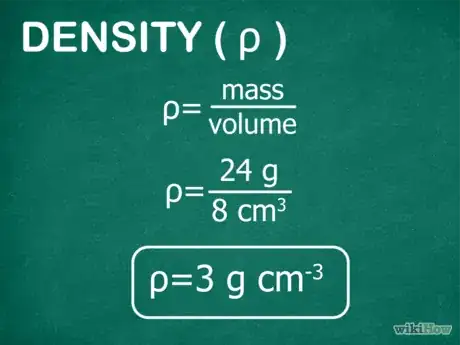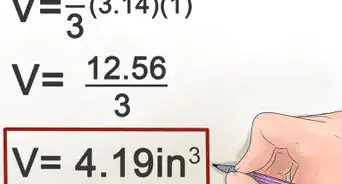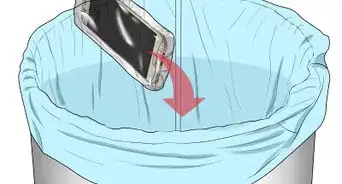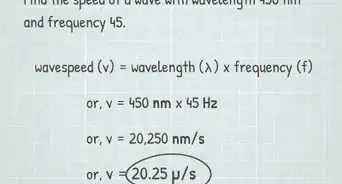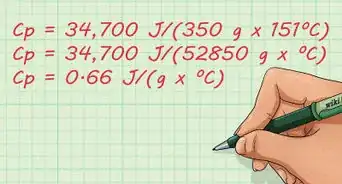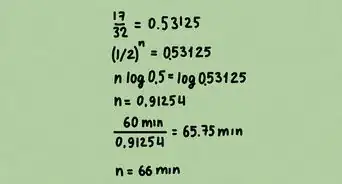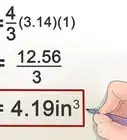This article was co-authored by Jessie Antonellis-John. Jessie Antonellis-John is a Math and Science Instructor who teaches at Southwestern Oregon Community College. With over 10 years of experience, she specializes in curriculum development. Jessie earned her PhD in Teaching & Teacher Education from the University of Arizona, her Master of Education from Western Governors University, and her BS in Astrophysics from Mount Holyoke College. She’s also co-authored several peer-reviewed journal articles in professional publications.
There are 16 references cited in this article, which can be found at the bottom of the page.
This article has been viewed 520,749 times.
Volume is the amount of space an object occupies while density is the mass of an object per unit volume. You need to know the volume of an object before you can calculate its density. Calculating volume for regular objects can be done with a simple formula determined by the shape of the object. Common units for volume are cubic centimeters (cm3), cubic meters (m3), cubic inches (in3), and cubic feet (ft3). Once you have the volume, density is one more simple calculation away. Common units for density are grams per cubic centimeter (g/cm3) or grams per milliliter (g/mL).
Steps
Calculating the Volume of Regular Object
-
1Determine the shape of your object. Knowing the shape of an object allows you to choose the proper formula and make the necessary measurements to calculate the volume.
- A sphere is a perfectly round three-dimensional object, in which every point on the surface is an equal distance from the center. In other words, a sphere is a ball-shaped object.[1]
- A cone is a 3-dimensional solid that has a circular base and a single vertex (the point of the cone). Another way to think of this is that a cone is a special pyramid that has a circular base.[2]
- A cube is a three-dimensional shape that has six identical square faces.[3]
- A rectangular solid, also known as a rectangular prism, is similar to a cube in that it is a three-dimensional shape with six sides, but in this case, the sides are rectangular instead of square.[4]
- A cylinder is a three-dimensional shape that has two identical flat ends that are circular in shape, and a single curved side that connects them.[5]
- A pyramid is a three-dimensional shape with a polygon for a base, and lateral faces that taper at an apex (the point of the pyramid). A regular pyramid is a pyramid in which the base of the pyramid is a regular polygon, meaning that all of the sides of the polygon are equal in length, and all of the angles are equal in measure.[6]
- If your object has an irregular shape, you can use the displacement method to determine volume.
-
2Choose the correct equation to calculate volume. Each shape has its own formula that calculates how much three-dimensional space that object occupies. Below are the formulas for the objects listed above. Check out How to Calculate Volume for more detailed notes and images on these formulas.
- Sphere: where r is the radius of the sphere.[7]
- Cone: where r is the radius of the circular base and h is the height of the cone.[8]
- Cube: where s is the length of any edge.[9]
- Rectangular prism: where l is the length of a side of a rectangular face, w is the width of a rectangular face, and h is the height of the prism.[10]
- Cylinder: where r is the radius of the circular base and h is the height of the cone.[11]
- Pyramid: where B is the area of the base of the pyramid and h is the height of the pyramid.[12]
Advertisement -
3Make the necessary measurements. The measurements you need to take will be determined by the shape of your object. For most objects you will need the height, but will only need the radius if the shape is circular or length and width for objects with rectangular faces.
- The radius of a circle is half of the diameter. Measure the diameter by placing a ruler across the middle of the circle and reading the end of the ruler. Calculate the radius by dividing the diameter by 2.
- Finding the radius of a sphere requires slightly more effort, but can be done in a number of ways detailed in how to find the radius of a sphere.
- The length, width, and height of objects can be measured with a ruler starting at one end of the object and recording where it stops on the other end of the object.
-
4Calculate the volume. Now that you have determined the shape, which formula to use, and made the necessary measurements, you can calculate volume. By plugging in the values of your measurements and doing the math. Your finished product is the volume of your object.
- Remember to express your answer in cubic units. Whether you are using metric or SI, the unit of volume will always be cubic. Be sure to always add units to the end of your calculation.
Calculating the Volume of an Irregular Object
-
1Calculate the volume of the object using displacement. Measuring dimensions of objects that are irregularly shaped can be difficult and lead to inaccurate measurements and calculations of volume. By measuring the amount of water displaced by an object, you can easily determine its volume without complex formulas.[13]
- This method can also be used to determine the volume of a regular shape.
-
2Fill a graduated cylinder with water. A graduated cylinder is a piece of lab equipment that has graduated markings on the outside and allows you to measure the volume of liquids. Make sure the graduated cylinder is large enough to contain your object. You want to fill it with enough water to completely submerge the object, but not overflow. Record the starting water level of the beaker.
- When you record the starting volume of water, be sure to look at the water at eye level and record the value at the bottom of the meniscus. The meniscus is the curve that the water takes when it comes in contact with another surface.[14]
-
3Gently place the object in the beaker. Take care not to drop the object in the water as this can lead to some water splashing out of the graduated cylinder. Ensure that your object is fully submerged. Record the new water level of the beaker, again at eye level paying close attention to the meniscus.
- If any water overflows when you place the object in the beaker, try again with a larger graduated cylinder or use less water.
-
4Subtract the new water level from the starting water level. The amount of water the object displaces is equal to the volume of the object itself measured in cubic centimeters. Liquids are generally measured in milliliters, however, one milliliter is equal to one cubic centimeter.[15]
- For example, if you started with 35 mL of water and ended with 65 mL of water, the volume of your object is 65 – 35 = 30 mL or 30 cm3
Calculating Density
-
1Determine the mass of the object. The amount of matter in an object is the mass of that object.[16] It is measured directly by weighing the object on a scale and its unit is grams.
- Find an accurate scale and place the object on it. Record its mass in your notebook.
- You can also measure mass with a balance. With your object on one side, place weights of known mass on the other side until both sides of the scale are balanced. The mass of your object is equal to the total mass of the balance weights.
- It's important to make sure your object is dry before weighing. This ensures that absorbed water does not affect the accuracy of the weighing.
- If you're measuring the mass of the liquid, weigh the empty container first. Fill the container and weigh it again. Then, just subtract the mass of the container from the mass of the liquid.
-
2Calculate the volume of your object. If your object has a regular shape, calculate the volume using one of the methods detailed above. If the shape is irregular, calculate the volume using the displacement method also detailed above.
-
3Calculate the density. Density is defined as mass divided by volume. To finish your measurement of density, divide the mass you measured by the volume you calculated. The result is the density of the metal measured in g/cm3.[17]
- For example, calculate the density of a substance with a volume of 8 cm3 and a mass of 24 g.
Community Q&A
-
QuestionWhat volume of dirt do I need to fill a hole with a diameter of 16 feet and a depth of 20 feet?
 Community AnswerIf we assume that the hole is cylindrical, the volume would be r²πh, where the radius (r) is 8 and the height (h) is 20. Then you have 64 * π * 20, which equals approximately 4,021. Thus you will need 4,021 cubic feet of dirt.
Community AnswerIf we assume that the hole is cylindrical, the volume would be r²πh, where the radius (r) is 8 and the height (h) is 20. Then you have 64 * π * 20, which equals approximately 4,021. Thus you will need 4,021 cubic feet of dirt. -
QuestionThere is a solid cone base radius of 6 cm and a vertical height of 8 cm that is made of metal whose density is 3.1g/cm cube. What is the mass of the cone?
 Community AnswerFirst what is the formula for the volume of a cone? (π)(r^2)(h/3). So when you input the parameters you get approximately 301.59 cm cubed. This is the volume. Since the density of the metal is 3.1g/cm cubed it means that each cm cubed weighs 3.1g. So you take the volume and multiply it by the density, which comes to 934.929 grams.
Community AnswerFirst what is the formula for the volume of a cone? (π)(r^2)(h/3). So when you input the parameters you get approximately 301.59 cm cubed. This is the volume. Since the density of the metal is 3.1g/cm cubed it means that each cm cubed weighs 3.1g. So you take the volume and multiply it by the density, which comes to 934.929 grams. -
QuestionWhat sign do you use for calculating mass/volume?
 Community AnswerIt's the division sign, which, on most computers is the '/' or "slash" is used, so 1/4 is the same as one divided by four, (= one quarter) which may also be written in decimals as 0.25. So, in the example, (density=mass/volume), the mass is divided by the volume.
Community AnswerIt's the division sign, which, on most computers is the '/' or "slash" is used, so 1/4 is the same as one divided by four, (= one quarter) which may also be written in decimals as 0.25. So, in the example, (density=mass/volume), the mass is divided by the volume.
Warnings
- Be careful to put all dimensions in metric or SI units before calculating anything.⧼thumbs_response⧽
Expert Interview

Thanks for reading our article! If you'd like to learn more about density of liquids, check out our in-depth interview with Jessie Antonellis-John.
References
- ↑ https://www.mathsisfun.com/definitions/sphere.html
- ↑ http://www.mathopenref.com/cone.html
- ↑ https://www.mathsisfun.com/definitions/cube.html
- ↑ https://www.mathsisfun.com/definitions/rectangular-prism.html
- ↑ https://www.mathsisfun.com/definitions/cylinder.html
- ↑ https://www.cuemath.com/geometry/pyramid/
- ↑ https://www.khanacademy.org/math/cc-eighth-grade-math/cc-8th-geometry/cc-8th-volume/v/volume-of-a-sphere
- ↑ https://virtualnerd.com/pre-algebra/perimeter-area-volume/volume/volume-formulas/cone-volume-formula
- ↑ https://www.ducksters.com/kidsmath/finding_the_volume_of_a_cube_or_box.php
- ↑ https://www.khanacademy.org/math/cc-fifth-grade-math/5th-volume/volume-word-problems/a/volume-of-rectangular-prisms-review
- ↑ https://www.omnicalculator.com/math/cylinder-volume
- ↑ https://www.khanacademy.org/math/geometry/hs-geo-solids/xff63fac4:hs-geo-cavalieri-s-principle/a/volume-of-a-pyramid-or-cone
- ↑ https://www.bbc.co.uk/bitesize/guides/zsjpcj6/revision/2
- ↑ http://water.usgs.gov/edu/meniscus.html
- ↑ https://sciencing.com/ways-determine-density-2508.html
- ↑ https://www.omnicalculator.com/physics/density
- ↑ https://www.omnicalculator.com/physics/density
About This Article
Before you calculate density, calculate volume using the object's volume formula. For example, for a rectangular prism, measure its length, width, and height, then solve for volume using the formula where volume equals length × width × height. After you have your object’s volume, determine its mass by weighing it on a scale or with a balance. You can then calculate density by dividing the mass by the volume. For more how to calculate density by using displacement when you have an irregular object, keep reading!
